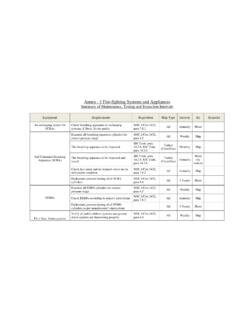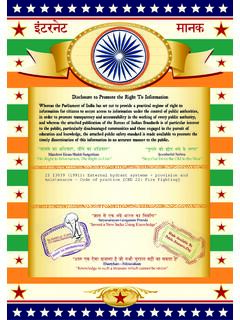Transcription of Fire fighting Training - Epralima
1 1 | Fire- fighting Training Manual Fire fighting Training Manual 2 | Fire- fighting Training Manual Index Abbreviations/ Acronyms .. 3 Figure and Table Index .. 4 Introductory Note .. 5 1 Fire | Conflagration .. 6 2 Phenomenology of Combustion .. 8 | Forms of Combustion .. 9 | Manifestations and combustion products .. 10 3 | Fire Classes .. 12 4 | Fire Extinction .. 14 | Extinction Methods .. 15 | Extinguishing 15 | Means of First Intervention .. 16 5 | Safety Signs and Symbols.
2 17 6 | Final Note .. 17 Bibliographical References .. 17 Technical Sheet .. 17 3 | Fire- fighting Training Manual Abbreviations/ Acronyms R - Right L - Left Fig. - Figure n - Number p. - Page ESEnfVC - Viana do Castelo s Nurses College FDSS (RIA) - Fire Detectors and Sprinkler Systems (Reds de Inc ndio Armadas) 4 | Fire- fighting Training Manual Figure and Table Index p.
3 Fig. n 1- Fire in an urban neighbourhood 6 Fig. n 2- Fire Tetrahedron/ Triangle 7 Fig. n 3- Manifestations and Combustion Products 8 Table n 1- Fire Triangle Components 6 Table n 2- Types of Combustion 7 Table n 3- Fires Classes 8 Table n 4- Extinction methods 9 Table n 5- Adequacy between fire classes and
4 Extinguishing agents 10 Table n 6- First intervention means 11 Table n 7- Safety signs and symbols 12 Table n 8- Safety signs 13 5 | Fire- fighting Training Manual Introductory Note There s an old saying that prevention is always more effective and cheaper than the cure. The irrefutability of the popular aphorism quoted above, the growing preoccupation with questions based on safety and the fact that collective and personal safety are an inherent principle of basic human necessities, in the concept of citizenship and in communal and individual wellbeing, makes Training in this area play a role of extreme importance.
5 According to this perspective ESEnfVC, in the context of its social and pedagogic functions, worries about creating conditions for the creation and consolidation of safety habits within the school community. This manual was elaborated, due to this preoccupation, with the intention of collecting a conjunction of guides which may help the development of Training regarding elementary aspects of safety, such as, first intervention means and safety signs. Thus, the purpose of this document is to: - Contribute towards Training in the safety area; - Collect information, norms and bibliographical sources necessary to train the school community in this area; - Create a document, in writing, that serves as a basis for Training regarding means of first interventions and safety signs/symbols.
6 This manual is divided in five captures which deal with the following aspects: fire/conflagration definition and its importance/ damage to Humanity; phenomenology of combustion approach the aspects susceptible to influence this reaction: fire classes reference to the types of fires related to combustible materials; fire extinction explanation of the methods/means and agents used to put out/control fires; safety signs and symbols principle aspects to be taken into consideration regarding the interpretation/identification of evacuation signs and extinction devices are referenced.
7 We hope this manual will be easy to consult and turn into a valuable informative instrument and promote a better culture on the responsibility of safety. 6 | Fire- fighting Training Manual Empirical discoveries generally occurred according to a sequence that involves, roughly, observation, experimentation and application. Fire did not avoid that rule having contributed since its discovery towards the advancement of humanity and the technological development left from this 1 Fire | Conflagration 7 | Fire- fighting Training Manual very same discovery.
8 However, when Men loose control of a Fire, conflagration starts, with all the losses and damage that it can cause. Therefore, we can say that conflagration is all or any type of non circumscribed fire, considered a reaction of combustion, in other words, a chemical reaction initiated and developed by an activated reaction, capable of combining a combustible element with an oxidizing agent. Besides heat, fire emits smoke and/or flames and gases, which can reach Dantesque proportions and be difficult to control.
9 8 | Fire- fighting Training Manual In order to control a fire, avoid its reproduction and extinguish it, it is necessary to know the fundamentals of fire, combustion, fuel, oxidizing agents, activation energy and chain reactions. Combustion is an oxidation reaction between a combustible body and oxygen. This reaction is provoked by specific activation energy, such as exothermic types, in other words, which release heat.
10 Even if combustion processes are very complex they can be represented by a triangle, in which each side represents one of the three essential factors required to produce fire: fuel, oxidizing agents and activation energy. 2 Phenomenology of Combustion 9 | Fire- fighting Training Manual Table n 1 Components of the fire triangle FuelAll and any type of substance, which in the presence of oxygen and activation energy is capable of burning. OxygenIt is the gas, that when present, causes fuel to burn, in its general form oxygen is considered a typical oxidizing agent found in normal air (in an approximate proportion of 21%).







